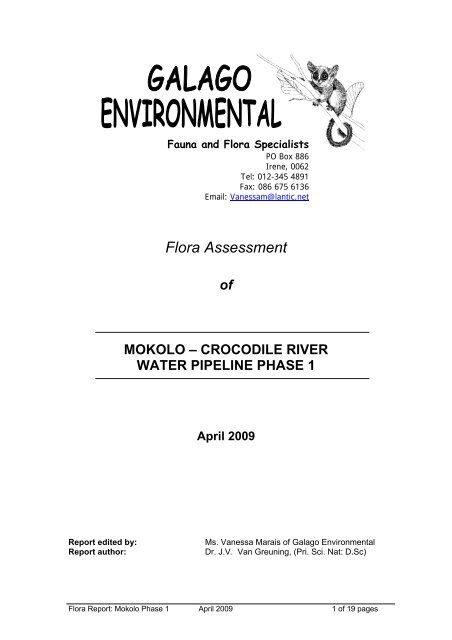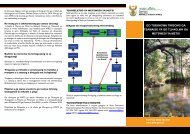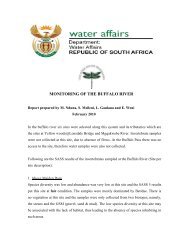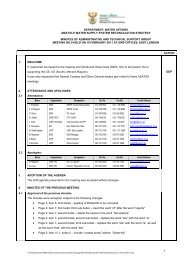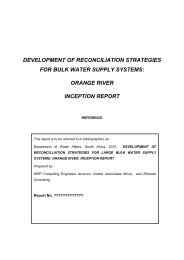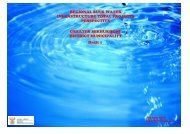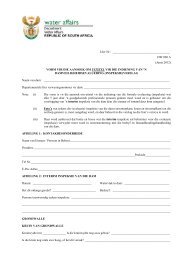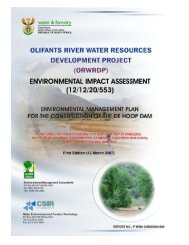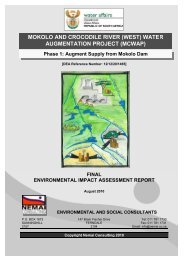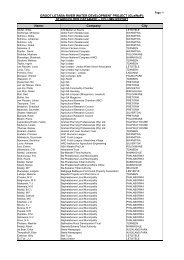Fauna and Flora Specialists - DWA Home Page
Fauna and Flora Specialists - DWA Home Page
Fauna and Flora Specialists - DWA Home Page
You also want an ePaper? Increase the reach of your titles
YUMPU automatically turns print PDFs into web optimized ePapers that Google loves.
<strong>Fauna</strong> <strong>and</strong> <strong>Flora</strong> <strong>Specialists</strong><br />
PO Box 886<br />
Irene, 0062<br />
Tel: 012-345 4891<br />
Fax: 086 675 6136<br />
Email: Vanessam@lantic.net<br />
<strong>Flora</strong> Assessment<br />
of<br />
MOKOLO – CROCODILE RIVER<br />
WATER PIPELINE PHASE 1<br />
April 2009<br />
Report edited by: Ms. Vanessa Marais of Galago Environmental<br />
Report author: Dr. J.V. Van Greuning, (Pri. Sci. Nat: D.Sc)<br />
<strong>Flora</strong> Report: Mokolo Phase 1 April 2009 1 of 19 pages
TABLE OF CONTENTS<br />
1. INTRODUCTION................................................................................... 3<br />
2. OBJECTIVES OF THE STUDY............................................................. 3<br />
3. SCOPE OF STUDY .............................................................................. 3<br />
4. STUDY AREA ....................................................................................... 3<br />
5. METHODS ............................................................................................ 4<br />
6. RESULTS.............................................................................................. 5<br />
6.1 Plant communities .............................................................................5<br />
6.2 Medicinal species ..............................................................................5<br />
6.3 Alien species .....................................................................................5<br />
6.4 Orange listed species ........................................................................5<br />
6.5 Red listed species .............................................................................5<br />
6.6 Limpopo Sweet Bushveld (Annexure A) ............................................6<br />
6.7 Waterberg Mountain Bushveld (Annexure A) ....................................9<br />
7. FINDINGS AND POTENTIAL IMPLICATIONS ................................... 13<br />
8. RECOMMENDED MITIGATION MEASSURES .................................. 14<br />
9. CONCLUSION .................................................................................... 15<br />
10. REFERENCES.................................................................................... 15<br />
ANNEXURE A: VEGETATION MAP OF THE STUDY ROUTE ..................... 16<br />
ANNEXURE B: PLANT SPECIES RECORDED ON PIPELINE ROUTE ....... 17<br />
FIGURES:<br />
Figure 1: Locality map of the study site...................................................................... 4<br />
Figure 2: The Phase 1 pipeline route indicating the location of waypoints ............... 5<br />
Figure 3: Trees <strong>and</strong> shrubs growing on s<strong>and</strong>y loam. ................................................. 6<br />
Figure 4: Acacia species <strong>and</strong> Spirostachys africana growing on clayey soils............ 7<br />
Figure 5: Vegetation on rocky, shallow s<strong>and</strong>y soil. .................................................. 10<br />
Figure 6: Vegetation on low-lying, deep s<strong>and</strong>y soil. ................................................ 10<br />
Figure 7: Kirkia accuminata growing at the Waterberg Mountain Bushveld............. 11<br />
TABLES:<br />
Table 1: Plant species recorded in the Limpopo Sweet Bushveld....................... 7<br />
Table 2: Plant species recorded in the Waterberg Mountain Bushveld............. 11<br />
<strong>Flora</strong> Report: Mokolo Phase 1 April 2009 2 of 19 pages
1. INTRODUCTION<br />
Galago Environmental CC was appointed to undertake a botanical study along the<br />
proposed route for the Mokolo-Crocodile river pipeline phase 1. The objective of the<br />
study was to delimit <strong>and</strong> map plant communities along the proposed pipeline route<br />
<strong>and</strong> to list the plant species occurring in each community. Special attention was paid<br />
to the presence or possible presence of Red Data species, Orange Listed species,<br />
alien species <strong>and</strong> medicinal species. The current ecological status <strong>and</strong> the<br />
conservation priority of the vegetation on the site were assessed.<br />
2. OBJECTIVES OF THE STUDY<br />
• To assess the current habitat <strong>and</strong> conservation status on the study site.<br />
• To list the species on the site <strong>and</strong> to recommend necessary actions in case of<br />
occurrence of endangered, vulnerable or rare species.<br />
• To highlight potential impacts of the development on the vegetation of the<br />
pipeline route.<br />
• To provide management recommendations to mitigate negative <strong>and</strong> enhance<br />
positive impacts should the proposed development be approved.<br />
3. SCOPE OF STUDY<br />
• All plant species discernable at the date of the survey are listed.<br />
• Medicinal <strong>and</strong> alien species are indicated with symbols in the tables.<br />
• The ecological sensitivity <strong>and</strong> conservation priority of the vegetation are<br />
evaluated.<br />
• Measures to minimize the negative impact of development on the vegetation<br />
are suggested.<br />
4. STUDY AREA<br />
The pipeline route is located in several quarter degree grid squares ranging from<br />
Steenbokpan in the west to Lephalale in the east <strong>and</strong> then south to Mokolo dam<br />
(Figure 1; Annexure A). It extends from west to east over the Limpopo Sweet<br />
Bushveld <strong>and</strong> Waterberg Mountain Bushveld to the south. In the area of waypoint<br />
031 some elements of Central S<strong>and</strong>y Bushveld such as Acacia burkei, Combretum<br />
zeyheri <strong>and</strong> Terminalia sericea occur but the vegetation still closely resembles<br />
Waterberg Mountain Bushveld.<br />
The Limpopo Sweet Bushveld extends from the Crocodile <strong>and</strong> Marico rivers down<br />
the Limpopo river valley into the tropics past Tom Burke. The l<strong>and</strong>scape features<br />
plains, some areas undulating or irregular with thickets of Acacia erubescens, Acacia<br />
mellifera <strong>and</strong> Dichrostachys cinerea in disturbed areas. The vegetation unit is<br />
considered least threatened. Less than 1% is statutorily conserved <strong>and</strong> about 5%<br />
transformed, mainly by cultivation (Mucina & Rutherford, 2006).<br />
Waterberg Mountain Bushveld is located in the Waterberg Mountains, including the<br />
foothills, escarpment <strong>and</strong> tablel<strong>and</strong>s south of the line between Lephalale <strong>and</strong><br />
Marken. The l<strong>and</strong>scape consists of rugged mountains with vegetation grading from<br />
<strong>Flora</strong> Report: Mokolo Phase 1 April 2009 3 of 19 pages
Faurea saligna-Protea caffra bushveld on higher slopes to Burkea africana-<br />
Terminalia sericea savanna in the lower-lying valleys. The grass layer is moderately<br />
developed. The conservation status is regarded least threatened. About 9% is<br />
statutorily conserved mainly in the Marakele National Park <strong>and</strong> Moepel Nature<br />
Reserve. More than 3% is transformed by cultivation (Mucina & Rutherford, 2006).<br />
N<br />
5. METHODS<br />
Study route<br />
for phase 1<br />
Figure 1: Locality map of the study site.<br />
The survey was carried out on 25 <strong>and</strong> 26 March 2009. Eleven waypoints were<br />
r<strong>and</strong>omly chosen along the Phase 1 pipeline route <strong>and</strong> the plants in a strip plot 100m<br />
long <strong>and</strong> 50m wide were identified at each waypoint (Figure 2). The locations of<br />
waypoints were precisely determined with GPS <strong>and</strong> plotted on the pipeline route with<br />
GIS. The delimitation of vegetation units is indicated on the satellite maps provided in<br />
Annexure A.<br />
The site was scrutinised for Red Data <strong>and</strong> Orange Listed species that might occur in<br />
this habitat. Attention was also paid to the occurrence of alien species <strong>and</strong> declared<br />
weeds.<br />
<strong>Flora</strong> Report: Mokolo Phase 1 April 2009 4 of 19 pages
Figure 2: The Phase 1 pipeline route indicating the location of waypoints 020 to 032.<br />
6. RESULTS<br />
6.1 Plant communities<br />
It was not attempted to delimit communities in a study area of such vast extent.<br />
However, the different vegetation units were mapped <strong>and</strong> the variation in species<br />
composition as a result of differences in edaphic factors, moisture <strong>and</strong> altitude in<br />
each unit discussed.<br />
6.2 Medicinal species<br />
Medicinal plant species are indicated in tables 1 <strong>and</strong> 2. Of the 166 plant species<br />
recorded on the pipeline route, 10 species were reported to have medicinal<br />
properties (Van Wyk et al. 2002; Van Wyk & Wink, 2004).<br />
6.3 Alien species<br />
The alien plant species are indicated in the tables with an asterisk. The diversity of<br />
alien species is low because of the natural condition of the vegetation. The names of<br />
Category 1 Declared weeds are printed in bold <strong>and</strong> the removal of these plants is<br />
compulsory by law.<br />
6.4 Orange listed species<br />
No Orange Listed species were found on the study site.<br />
6.5 Red listed species<br />
No Red Data species were found on the study site.<br />
<strong>Flora</strong> Report: Mokolo Phase 1 April 2009 5 of 19 pages
6.6 Limpopo Sweet Bushveld (Annexure A)<br />
The soil is predominantly s<strong>and</strong>y loam with dominant tree species Combretum<br />
apiculatum, Acacia erubescens, Acacia nigrescens <strong>and</strong> Commiphora species;<br />
dominant shrub species are Grewia monticola, Grewia bicolor, Grewia flava <strong>and</strong><br />
Euclea undulata. Eragrostis rigidior, Urochloa mosambicensis <strong>and</strong> Eragrostis<br />
congesta are the most abundant grass species (Figure 3). In disturbed areas <strong>and</strong> low<br />
-lying clayey areas thickets of Acacia erubescens, Acacia mellifera, Dichrostachys<br />
cinerea <strong>and</strong> Spirostachys africana are dominant (Figure 4).<br />
Of the 117 species recorded, nine species are known to have medicinal properties.<br />
Only four alien species were recorded of which Cereus jamacaru is a Category 1<br />
Declared weed <strong>and</strong> must be eradicated. No Red Data or Orange Listed species were<br />
found.<br />
Except for the zone running through the town of Steenbokspan <strong>and</strong> the developed<br />
areas near Lephalale, the vegetation along the pipeline route can be regarded as<br />
sensitive <strong>and</strong> has a high conservation priority. The occurrence of protected trees<br />
such as Sclerocarya birrea is of importance.<br />
Figure 3: Trees <strong>and</strong> shrubs growing on s<strong>and</strong>y loam.<br />
<strong>Flora</strong> Report: Mokolo Phase 1 April 2009 6 of 19 pages
Figure 4: Acacia species <strong>and</strong> Spirostachys africana growing on clayey soils.<br />
Table 1: Plant species recorded in the Limpopo Sweet Bushveld.<br />
Alien species are indicated by * <strong>and</strong> medicinal species by ♥.<br />
SCIENTIFIC NAME COMMON NAME<br />
Acacia burkei Black monkey thorn<br />
Acacia caffra Common hook-thorn<br />
Acacia erioloba Camel thorn<br />
Acacia erubescens Blue thorn<br />
Acacia karroo♥ Sweet thorn<br />
Acacia mellifera subsp. detinens Black thorn<br />
Acacia nigrescens Knob-thorn<br />
Acacia nilotica Scented pod<br />
Acacia robusta subsp. rubusta Broad-pod robust thorn<br />
Acacia tortilis subsp. heteracantha Umbrella thorn<br />
Achyranthes aspera var. aspera* Burweed<br />
Albizia anthelmintica♥ Worm-bark false-thorn<br />
Albizia harveyi Bushveld false-thorn<br />
Aloe chabaudii<br />
Ammocharis coranica Seeroogblom<br />
Aristida adscensionis Annual three-awn<br />
Aristida congesta subsp. barbicollis Spreading three-awn<br />
Aristida congesta subsp. congesta Tassel three awn<br />
Aristida stipitata Long-awned grass<br />
Asparagus sp. Wild asparagus<br />
Bauhinia petersiana subsp. macrantha Kalahari bauhinia<br />
Blepharis integrifolia var. integrifolia<br />
Boscia albitrunca Shepherd tree<br />
Boscia foetida subsp. rehmanniana Foetid shepherd tree<br />
Bothriochloa insculpta Pinhole grass<br />
Burkea africana Wild seringa<br />
Carissa bispinosa Forest num-num<br />
Cenchrus ciliaris Foxtail buffalo grass<br />
<strong>Flora</strong> Report: Mokolo Phase 1 April 2009 7 of 19 pages
SCIENTIFIC NAME COMMON NAME<br />
Cereus jamacaru* Queen of the night<br />
Chamaecrista capensis var. capensis<br />
Chloris virgata Feather-top chloris<br />
Clerodendrum ternatum<br />
Combretum apiculatum Red bush-willow<br />
Combretum hereroense Russet bush-willow<br />
Combretum zeyheri Large-fruited bush-willow<br />
Commelina africana<br />
Commelina benghalensis<br />
Commelina sp.<br />
Commiphora angolensis S<strong>and</strong> corkwood<br />
Commiphora mollis Velvet-leaved corkwood<br />
Commiphora pyracanthoides Common corkwood<br />
Crotalaria eremicola subsp. eremicola<br />
Cucumis zeyheri Wild cucumber<br />
Cyperus margaritaceus var<br />
margaritaceus<br />
Dicerocaryum eriocarpum Devil’s thorn<br />
Dichrostachys cinerea subsp. africana Small-leaved sickle bush<br />
var. africana<br />
Dicoma tomentosa<br />
Digitaria eriantha Common finger grass<br />
Diheteropogon amplectens Broad-leaved bluestem<br />
Dombeya rotundifolia var. rotundifolia♥ Wild pear<br />
Ehretia rigida Puzzle bush<br />
Elephantorrhiza elephantina♥ Elephant’s root<br />
Enneapogon cenchroides Nine-awned grass<br />
Eragrostis gummiflua Gum grass<br />
Eragrostis pallens Broom love grass<br />
Eragrostis rigidior Curly leaf<br />
Eragrostis superba Saw-tooth love grass<br />
Eragrostis trichophora Hairy love grass<br />
Euclea natalensis subsp. angustifolia Natal guarri<br />
Euclea undulata♥ Small-leaved guarri<br />
Evolvulus alsinoides<br />
Gardenia volkensii subsp. spathulifolia Bushveld gardenia<br />
Grewia bicolor White raisin<br />
Grewia flava Velvet raisin<br />
Grewia flavescens S<strong>and</strong>paper raisin<br />
Grewia monticola Grey raisin<br />
Gymnosporia buxifolia Spike-thorn<br />
Harpagophytum zeyheri subsp. zeyheri♥<br />
Hermbsteadtia odorata var. odorata Rooiaarbossie<br />
Heteropogon contortus Spear grass<br />
Heteropogon melanocarpus<br />
Hibiscus cannabinus* Wild stockrose<br />
Indigofera daleoides var. daleoides<br />
Ipomoea magnusiana<br />
Ipomoea obscura var. obscura Wild petunia<br />
Justicia flava<br />
Kyphocarpa angustifolia<br />
<strong>Flora</strong> Report: Mokolo Phase 1 April 2009 8 of 19 pages
SCIENTIFIC NAME COMMON NAME<br />
Lannea discolor Live-long<br />
Lantana rugosa Bird’s br<strong>and</strong>y<br />
Maerua angolensis Bead-bean<br />
Melhania forbesii<br />
Melinis repens subsp. gr<strong>and</strong>iflora Natal red top<br />
Monsonia angustifolia Crane’s bill<br />
Ocimum americanum subsp. americanum<br />
Ozoroa paniculosa var. paniculosa Resin tree<br />
Panicum maximum Guinea grass<br />
Pavetta lanceolata Bridal bush<br />
Perotis patens Cat’s tail<br />
Phyllanthus parvulus Dye bush<br />
Pogonarthria squarrosa Herringbone grass<br />
Portulaca kermesina<br />
Portulaca quadrifida* Wild purslane<br />
Rhoicissus revoilii Bushveld grape<br />
Rhynchosia totta<br />
Sarcostemma viminale subsp. viminale Melktou<br />
Schmidtia pappophoroides S<strong>and</strong> quick<br />
Sclerocarya birrea subsp. caffra♥ Marula<br />
Setaria ustilata<br />
Sida alba Spiny sida<br />
Sida dregei Spider-leg<br />
Solanum p<strong>and</strong>uriforme Poison apple<br />
Solanum tettense var. renschii<br />
Spirostachys africana Tamboti<br />
Sterculia rogersii Star chestnut<br />
Stipagrostis uniplumis var. uniplumis Silky bushman grass<br />
Tephrosia rhodesica var. rhodesica<br />
Terminalia sericea♥ Silver cluster-leaf<br />
Tragia rupestris<br />
Tylosema esculentum<br />
Urochloa mosambicensis Bushveld signal grass<br />
Vernonia poskeana subsp. botswanica<br />
Waltheria indica<br />
Xenostegia tridentata subsp. angustifolia<br />
Ximenia americana var. microphylla Blue sourplum<br />
Ximenia caffra var. caffra Sourplum<br />
Ziziphus mucronata♥ Buffalo thorn<br />
Zornia milneana<br />
6.7 Waterberg Mountain Bushveld (Annexure A)<br />
The soil is mainly coarse-grained shallow <strong>and</strong> s<strong>and</strong>y, alternated by outcrops of<br />
s<strong>and</strong>stone <strong>and</strong> conglomerate. Diplorhynchus condylocarpon, Bridelia mollis,<br />
Pseudolachnostylis maprouneifolia <strong>and</strong> Albizia brevifolia are common tree species on<br />
rocky, shallow-soiled areas (Figure 5). In low-lying areas deep, fine-grained s<strong>and</strong>y<br />
soil is the preferred substrate for Terminalia sericea, Peltophorum africanum,<br />
Combretum zeyheri <strong>and</strong> Dombeya rotundifolia which are common for S<strong>and</strong>y<br />
Bushveld (Figure 6). An interesting phenomenon is the occurrence of Kirkia<br />
acuminata which is common in the Mopane Bushveld (Figure 7).<br />
<strong>Flora</strong> Report: Mokolo Phase 1 April 2009 9 of 19 pages
Seven of the 112 species recorded are known to have medicinal value <strong>and</strong> three<br />
alien species were found. No Red Data or Orange Listed species occur in this<br />
vegetation unit.<br />
The zone along the existing pipeline is already transformed; therefore it is not<br />
sensitive. The vegetation either side of the route <strong>and</strong> that of the section between<br />
Steenbokpan <strong>and</strong> Lephalale is natural primary savannah <strong>and</strong> are considered<br />
ecologically sensitive.<br />
Figure 5: Vegetation on rocky, shallow s<strong>and</strong>y soil.<br />
Figure 6: Vegetation on low-lying, deep s<strong>and</strong>y soil. Note the abundance of Silver<br />
cluster-leaf.<br />
<strong>Flora</strong> Report: Mokolo Phase 1 April 2009 10 of 19 pages
Figure 7: Kirkia accuminata growing at the margin of Waterberg Mountain Bushveld.<br />
Table 2: Plant species recorded in the Waterberg Mountain Bushveld.<br />
Alien species are indicated by * <strong>and</strong> medicinal species by ♥.<br />
SCIENTIFIC NAME COMMON NAME<br />
Acacia burkei Black monkey thorn<br />
Acacia erubescens Blue thorn<br />
Acacia mellifera subsp. detinens Black thorn<br />
Acacia nigrescens Knob-thorn<br />
Acacia nilotica Scented pod<br />
Acacia robusta subsp. robusta Broad-pod robust thorn<br />
Acacia senegal var. rostrata Bushy three-hook thorn<br />
Acalypha indica<br />
Achyranthes aspera var. aspera* Burweed<br />
Albizia brevifolia Rock false-thorn<br />
Albizia tanganyicensis Paper-barked false-thorn<br />
Aloe marlothii subsp. marlothii Mountain aloe<br />
Aristida congesta subsp. barbicollis Spreading three-awn<br />
Aristida congesta subsp. congesta Tassel three-awn<br />
Aristida stipitata Long-awned grass<br />
Boscia albitrunca Shepherd tree<br />
Brachiaria nigropedata Black-footed grass<br />
Bridelia mollis Velvet sweet-berry<br />
Chamaecrista capensis var. capensis<br />
Chloris virgata Feather-top chloris<br />
Chrysopogon serrulatus Golden beard grass<br />
Combretum apiculatum Red bush-willow<br />
Combretum imberbe Leadwood<br />
Combretum molle Velvet bush-willow<br />
Combretum zeyheri Large-fruited bush-willow<br />
Commelina sp.<br />
Commiphora mollis Velvet-leaved corkwood<br />
Corchorus kirkii<br />
<strong>Flora</strong> Report: Mokolo Phase 1 April 2009 11 of 19 pages
SCIENTIFIC NAME<br />
Corchorus longipedunculatus<br />
COMMON NAME<br />
Croton gratissimus var. gratissimus Lavender fever-berry<br />
Dicerocaryum eriocarpum Devil’s thorn<br />
Dichrostachys cinerea subsp. africana Small-leaved sickle bush<br />
var. africana<br />
Digitaria eriantha Common finger grass<br />
Diplorhynchus condylocarpon Horn-pod tree<br />
Dombeya rotundifolia var. rotundifolia♥ Wild pear<br />
Elephantorrhiza elephantina♥ Elephant’s root<br />
Englerophytum magalismontanum Stem-fruit<br />
Eragrostis aspera Rough love grass<br />
Eragrostis pallens Broom love grass<br />
Eragrostis rigidior Curly leaf<br />
Eragrostis trichophora Hairy love grass<br />
Euclea natalensis subsp. angustifolia Natal guarri<br />
Euclea undulata♥<br />
Euphorbia neopolycnemoides<br />
Small-leaved guarri<br />
Ficus abutilifolia Large-leaved rock fig<br />
Flueggea virosa subsp. virosa White-berry bush<br />
Gardenia volkensi subsp. spathulifolia Bushveld gardenia<br />
Gomphocarpus fruticosus♥ Milkweed<br />
Gomphrena celosioides* Bachelor’s button<br />
Grewia bicolor White raisin<br />
Grewia flava Velvet raisin<br />
Grewia flavescens S<strong>and</strong>paper raisin<br />
Grewia monticola Grey raisin<br />
Gymnosporia buxifolia Spike-thorn<br />
Gymnosporia tenuispina<br />
Hermannia grisea<br />
Bell spike-thorn<br />
Heteropogon contortus Spear grass<br />
Hexalobus monopetalus var.<br />
Shakama plum<br />
monopetalus<br />
Hibiscus trionum Bladderweed<br />
Indigofera daleoides var. daleoides<br />
Indigofera oxytropis<br />
Justicia flava<br />
Kirkia acuminata White seringa<br />
Kyphocarpa angustifolia<br />
Lannea discolor Live-long<br />
Limeum sp.<br />
Melhania burchellii<br />
Melhania forbesii<br />
Melinis repens subsp. gr<strong>and</strong>iflora Natal red top<br />
Mimusops zeyheri Moepel<br />
Mundulea sericea Cork bush<br />
Ochna inermis Stunted plane<br />
Ozoroa paniculosa var. paniculosa Resin tree<br />
Panicum maximum Guinea grass<br />
Pappea capensis Jacket-plum<br />
Pavetta lanceolata Bridal bush<br />
Pellaea calomelanos var. calomelanos<br />
<strong>Flora</strong> Report: Mokolo Phase 1 April 2009 12 of 19 pages
SCIENTIFIC NAME COMMON NAME<br />
Peltophorum africanum African wattle<br />
Perotis patens Cat’s tail<br />
Phyllanthus parvulus Dye bush<br />
Plumbago zeylanica* Wild white plumbago<br />
Pogonarthria squarrosa<br />
Portulaca kermesina<br />
Herringbone grass<br />
Pseudolachnostylis maprouneifolia var.<br />
maprouneifolia<br />
Kudu-berry<br />
Pterocarpus rotundifolius subsp.<br />
Round-leaved bloodwood<br />
rotundifolius<br />
Pupalia lappacea var. lappacea<br />
Rhoicissus revoilii Bushveld grape<br />
Rhynchosia totta<br />
Sarcostemma viminale subsp. viminale Melktou<br />
Schotia bracypetala Weeping boer-bean<br />
Sclerocarya birea subsp. caffra♥ Marula<br />
Setaria ustilata<br />
Sida cordifolia Flannel weed<br />
Sida dregei Spider-leg<br />
Solanum p<strong>and</strong>uriforme Poison apple<br />
Spermacoce senensis<br />
Spirostachys africana Tamboti<br />
Strychnos madagascariensis Black monkey orange<br />
Tephrosia longipes subsp. longipes<br />
Terminalia sericea♥ Silver cluster-leaf<br />
Tragia rupestris<br />
Tricholaena monachne Blue-seed grass<br />
Trichoneura gr<strong>and</strong>iglumis Small rolling grass<br />
Triumfetta rhomboidea var. rhomboidea<br />
Vernonia poskeana subsp. botswanica<br />
Vigna vexillata<br />
Waltheria indica<br />
Ximenia americana var. microphylla Blue sourplum<br />
Ximenia caffra var. caffra Sourplum<br />
Ziziphus mucronata♥ Buffalo thorn<br />
Zornia linearis<br />
Zornia milneana<br />
7. FINDINGS AND POTENTIAL IMPLICATIONS<br />
The vegetation along the Phase 1 route, outside the pipe reserve has a high<br />
conservation priority. L<strong>and</strong> use is aimed mainly on game farming which is not a<br />
degrading practice. Most of the areas adjacent to the pipeline zone are primary<br />
natural vegetation; consequently ample connectivity with natural vegetation exists.<br />
Protected trees occurring in the study area are Acacia erioloba, Boscia albitrunca,<br />
Combretum imberbe <strong>and</strong> Sclerocarya birrea subsp. africana. These species may not<br />
be harmed in any way or, if this is unavoidable, the necessary permit must be<br />
obtained from the Department of Forestry to remove some of the mentioned trees.<br />
<strong>Flora</strong> Report: Mokolo Phase 1 April 2009 13 of 19 pages
8. RECOMMENDED MITIGATION MEASSURES<br />
• An Ecological Management Plan (to be included in the Environmental<br />
Management Plan (EMP) must be developed for the construction <strong>and</strong><br />
operational phase of the development <strong>and</strong> should:<br />
o include an ongoing monitoring <strong>and</strong> eradication programme for all nonindigenous<br />
species, with specific emphasis on invasive <strong>and</strong> weedy<br />
species<br />
o ensure the persistence of all Red <strong>and</strong> Orange List species<br />
o minimize artificial edge effects (e.g. water runoff from developed areas<br />
<strong>and</strong> application of chemicals)<br />
o result in a report back to the Directorate of Nature Conservation on an<br />
annual basis.<br />
• Where possible, trees naturally growing on the site should be retained as part<br />
of the l<strong>and</strong>scaping, with specific emphasis on the following species: Acacia<br />
erioloba, Boscia albitrunca, Combretum imberbe, Sclerocarya birrea subsp.<br />
caffra. Measures to ensure that these trees survive the physical disturbance<br />
from the development should be implemented. A tree surgeon should be<br />
consulted in this regard. A qualified botanist must mark trees when the route<br />
is pegged <strong>and</strong> permits obtained from <strong>DWA</strong>F before any protected trees are<br />
removed.<br />
• The crossing of natural drainage systems should be minimized <strong>and</strong> only<br />
constructed at the shortest possible route, perpendicular to the natural<br />
drainage system. Where possible, bridge crossings should span the entire<br />
stretch of the buffer zone.<br />
Pipelines<br />
• The appropriate agency should implement an ongoing monitoring <strong>and</strong><br />
eradication program for all invasive <strong>and</strong> weedy plant species growing within<br />
the servitude.<br />
• Rehabilitation of natural vegetation should proceed in accordance with a<br />
rehabilitation plan compiled by a specialist registered in terms of the Natural<br />
Scientific Professions Act (No. 27 of 2003) in the field of Ecological Science.<br />
• Any post-development re-vegetation should use species indigenous to South<br />
Africa. Plant species locally indigenous to the area are preferred. As far as<br />
possible, indigenous plants naturally growing along the route, but would<br />
otherwise be destroyed during construction, should be used for re-vegetation.<br />
• Where a pipeline is to traverse a wetl<strong>and</strong>, measures are required to ensure<br />
that the pipeline has minimal effect on the flow of water through the wetl<strong>and</strong>,<br />
e.g. by using a high level clear span bridge or box culverts rather than pipes.<br />
• Disturbance to any wetl<strong>and</strong>s during construction should be minimized. A plan<br />
for the immediate rehabilitation of damage caused to wetl<strong>and</strong>s should be<br />
compiled by a specialist registered in accordance with the Natural Scientific<br />
Professions Act (No. 27 of 2003) in the field of Ecological Science. This<br />
rehabilitation plan should form part of the EMP <strong>and</strong> a record book should be<br />
maintained on site to monitor <strong>and</strong> report on the implementation of the plan.<br />
<strong>Flora</strong> Report: Mokolo Phase 1 April 2009 14 of 19 pages
9. CONCLUSION<br />
The vegetation on the pipeline route is considered sensitive <strong>and</strong> precautions should<br />
be taken to inflict as little damage as possible during the construction phase. Spilling<br />
of oil <strong>and</strong> fuel, dumping of rubble <strong>and</strong> water pollution must be strictly monitored. All<br />
Category 1 Declared weeds must be eradicated <strong>and</strong> protected trees should be left<br />
intact as far as possible.<br />
10. REFERENCES<br />
Bromilow, C. 2001. Problem plants of South Africa. Briza, Pretoria.<br />
Germishuizen, G., Meyer, N.L., Steenkamp, Y., & Keith, M. 2006. A checklist of<br />
South African plants. SABONET report no. 41, Pretoria.<br />
Golding, J.S.(ed.). 2002. Southern African plant red data lists. NBI, Pretoria.<br />
Henderson, L. 2001. Alien weeds <strong>and</strong> invasive plants. ARC, Pretoria.<br />
Low, A.B. & Rebelo, G. 1996. Vegetation of South Africa, Lesotho <strong>and</strong> Swazil<strong>and</strong>.<br />
Environmental Affairs <strong>and</strong> Tourism, Pretoria.<br />
Mucina,L. & Rutherford, C. (eds.). 2006. The vegetation of South Africa, Lesotho <strong>and</strong><br />
Swazil<strong>and</strong>. South African Biodiversity Institute, Pretoria.<br />
Pfab, M.F. & Victor. J.E. 2002. Threatened plants of Gauteng, South Africa. South<br />
African Journal of Botany 68: 370-375.<br />
Van Oudshoorn, F. 2002. Guide to grasses of southern Africa. Briza Publications,<br />
Pretoria.<br />
Van Wyk B-E, van oudshoorn b & gericke n 2002. Medicinal plants of South Africa.<br />
Briza Publications, Pretoria.<br />
Van Wyk, B. & Malan, S. 1988. Field guide to the wild flowers of the Witwatersr<strong>and</strong><br />
<strong>and</strong> Pretoria region. Struik, Cape Town.<br />
Van Wyk, B-E & Wink, M.2004. Medicinal plants of the world. An illustrated guide to<br />
important medicinal plants <strong>and</strong> their uses. Briza Publications, Pretoria.<br />
<strong>Flora</strong> Report: Mokolo Phase 1 April 2009 15 of 19 pages
ANNEXURE A: VEGETATION MAP OF THE STUDY ROUTE<br />
<strong>Flora</strong> Report: Mokolo Phase 1 April 2009 16 of 19 pages
ANNEXURE B: PLANT SPECIES RECORDED ON PROPOSED<br />
PHASE 1 PIPELINE ROUTE<br />
ACANTHACEAE<br />
Blepharis integrifolia<br />
Justicia flava<br />
AMARANTHACEAE<br />
Achyranthes aspera<br />
Gomphrena celosioides<br />
Hermbstaedtia odorata<br />
Kyphocarpa angustifolia<br />
Pupalia lappacea<br />
AMARYLLIDACEAE<br />
Ammocharis coranica<br />
ANACARDIACEAE<br />
Lannea discolor<br />
Ozoroa paniculosa<br />
Sclerocarya birrea<br />
ANNONACEAE<br />
Hexalobus monopetalus<br />
APOCYNACEAE<br />
Carissa bispinosa<br />
Diplorhynchus condylocarpon<br />
Gomphocarpus fruticosus<br />
Sarcostemma viminale<br />
ASTERACEAE<br />
Dicoma tomentosa<br />
Vernonia poskeana<br />
BURSERACEAE<br />
Commiphora angolensis<br />
Commiphora mollis<br />
Commiphora pyracanthoides<br />
CACTACEAE<br />
Cereus jamacaru<br />
CAESALPINIACEAE<br />
Bauhinia petersiana<br />
Burkea africana<br />
Chamaecrista capensis<br />
Peltophorum africanum<br />
Schotia brachypetala<br />
Tylosema esculentum<br />
CAPPARACEAE<br />
Boscia albitrunca<br />
Boscia foetida<br />
Maerua angolensis<br />
CELASTRACEAE<br />
Gymnosporia buxifolia<br />
Gymnosporia tenuispina<br />
COMBRETACEAE<br />
Combretum apiculatum<br />
Combretum hereroense<br />
Combretum imberbe<br />
Combretum molle<br />
Combretum zeyheri<br />
Terminalia sericea<br />
COMMELINACEAE<br />
Commelina africana<br />
Commelina benghalensis<br />
CONVOLVULACEAE<br />
Evolvulus alsinoides<br />
Ipomoea magnusiana<br />
Ipomoea obscura<br />
Xenostegia tridentata<br />
CUCURBITACEAE<br />
Cucumis zeyheri<br />
CYPERACEAE<br />
Cyperus margaritaceus<br />
EBENACEAE<br />
Euclea natalensis<br />
Euclea undulata<br />
EHRETIACEAE<br />
Ehretia rigida<br />
EUPHORBIACEAE<br />
Acalypha indica<br />
Croton gratissimus<br />
Euphorbia neopolycnemoides<br />
Spirostachys africana<br />
Tragia rupestris<br />
<strong>Flora</strong> Report: Mokolo Phase 1 April 2009 17 of 19 pages
FABACEAE<br />
Crotalaria eremicola<br />
Indigofera daleoides<br />
Indigofera oxytropis<br />
Mundulea sericea<br />
Pterocarpus rotundifolius<br />
Rhynchosia totta<br />
Tephrosia longipes<br />
Tephrosia rhodesica<br />
Vigna vexillata<br />
Zornia milneana<br />
Zornia linearis<br />
GERANIACEAE<br />
Monsonia angustifolia<br />
KIRKIACEAE<br />
Kirkia acuminata<br />
LAMIACEAE<br />
Clerodendendrum ternatum<br />
Ocimum americanum<br />
LILIACEAE<br />
Aloe chabaudii<br />
Aloe marlothii<br />
Asparagus sp.<br />
LIMEACEAE<br />
Limeum sp.<br />
MALVACEAE<br />
Hibiscus cannabinus<br />
Hibiscus trionum<br />
Melhania burchellii<br />
Melhania forbesii<br />
Sida alba<br />
Sida cordifolia<br />
Sida dregei<br />
MIMOSACEAE<br />
Acacia burkei<br />
Acacia caffra<br />
Acacia erioloba<br />
Acacia erubescens<br />
Acacia karroo<br />
Acacia mellifera<br />
Acacia nigrescens<br />
Acacia nilotica<br />
Acacia robusta<br />
Acacia senegal var. rostrata<br />
Acacia tortilis<br />
Albizia anthelmintica<br />
Albizia brevifolia<br />
Albizia harvei<br />
Albizia tanganyicensis<br />
Dichrostachys cinerea<br />
Elephantorrhiza elephantina<br />
MORACEAE<br />
Ficus abutilifolia<br />
OCHNACEAE<br />
Ochna inermis<br />
OLACACEAE<br />
Ximenia americana<br />
Ximenia caffra<br />
PEDALIACEAE<br />
Dicerocaryum eriocarpum<br />
Harpagophytum zeyheri<br />
PHYLLANTACEAE<br />
Bridelia mollis<br />
Flueggea virosa<br />
Phyllanthus parvulus<br />
Pseudolachnostylis maprouneifolia<br />
POACEAE<br />
Aristida adscensionis<br />
Aristida congesta subsp. barbicollis<br />
Aristida congesta subsp. congesta<br />
Aristida diffusa<br />
Aristida stipitata<br />
Bothriochloa insculpta<br />
Brachiaria nigropedata<br />
Cenchrus ciliaris<br />
Chloris virgata<br />
Chrysopogon serrulatus<br />
Digitaria eriantha<br />
Diheteropogon amplectens<br />
Enneapogon cenchroides<br />
Eragrostis aspera<br />
Eragrostis gummiflua<br />
Eragrostis pallens<br />
Eragrostis rigidior<br />
Eragrostis superba<br />
Eragrostis trichophora<br />
Heteropogon contortus<br />
Heteropogon melanocarpus<br />
Melinis repens<br />
Panicum maximum<br />
Perotis patens<br />
Pogonarthria squarrosa<br />
Schmidtia pappophoroides<br />
Setaria ustilata<br />
Stipagrostis uniplumis<br />
Tragus berteronianus<br />
Tricholaena monachne<br />
<strong>Flora</strong> Report: Mokolo Phase 1 April 2009 18 of 19 pages
Trichoneura gr<strong>and</strong>iglumis<br />
Urochloa mosambicensis<br />
PORTULACACEAE<br />
Portulaca kermesina<br />
Portulaca quadrifida<br />
PTERIDACEAE<br />
Pellaea calomelanos<br />
RHAMNACEAE<br />
Ziziphus mucronata<br />
RUBIACEAE<br />
Gardenia volkensii<br />
Pavetta lanceolata<br />
Spermacoce senensis<br />
SAPINDACEAE<br />
Pappea capensis<br />
SAPOTACEAE<br />
Englerophytum magalismontanum<br />
Mimusops zeyheri<br />
SOLANACEAE<br />
Solanum p<strong>and</strong>uriforme<br />
Solanum tettense<br />
STERCULIACEAE<br />
Dombeya rotundifolia<br />
Hermannia grisea<br />
Sterculia rogersii<br />
Waltheria indica<br />
STRYCHNACEAE<br />
Strychnos madagascariensis<br />
TILIACEAE<br />
Corchorus kirkii<br />
Corchorus longipendunculatus<br />
Grewia bicolor<br />
Grewia flava<br />
Grewia flavescens<br />
Grewia monticola<br />
Triumphetta rhomboidea<br />
VERBENACEAE<br />
Lantana rugosa<br />
VITACEAE<br />
Rhoicissus revoilii<br />
<strong>Flora</strong> Report: Mokolo Phase 1 April 2009 19 of 19 pages


